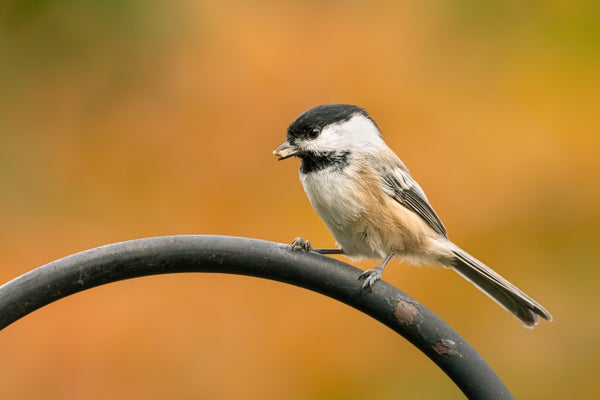Unique patterns of neuron activation help tiny birds catalog thousands of scattered food caches
Thank you for reading this post, don't forget to subscribe!
Black-capped Chickadee.
Luc Pouliot/Getty Images
Black-capped Chickadees don’t let food go to waste. These puffy little birds, with their oversize head and dark eyes resembling those of a Beanie Baby, are always hoarding extra grub such as berries, seeds and insects. A single bird of this species stores its surplus in thousands of hiding spots throughout the forest to make the sustenance ready for times of scarcity.
“When [a chickadee] hides a seed, it forms a memory of where the seed is, which it can later use,” says Selmaan Chettih, a postdoctoral researcher who studies these birds’ neural activity at Columbia University. And that memory is extraordinarily precise: chickadees can pinpoint the location of their scattered food caches down to the centimeter—and they remember which item they stashed in which spot.
So how do these birds store and use so many memories? In a new paper published on Friday in Cell, Chettih and his team were surprised to discover that Black-capped Chickadees activate unique barcodelike patterns in their brain when they hide and retrieve a food item. These neural “barcodes,” which have yet to be observed in any other species, may allow the birds to store and retrieve many similar memories without getting them mixed up.
On supporting science journalism
If you’re enjoying this article, consider supporting our award-winning journalism by subscribing. By purchasing a subscription you are helping to ensure the future of impactful stories about the discoveries and ideas shaping our world today.
Like mammals, chickadees and other birds form memories in their hippocampus. This brain structure—which is relatively large in food-caching birds—stores snapshots of past places or events. These isolated snippets, known as episodic memories, can be accessed later to recall certain experiences.
Less is known about how chickadees access episodic memories to find a specific stash. Chettih and his team had initially thought this process would be linked to a subset of neurons in the hippocampus called place cells, which encode an animal’s location at a particular time and form a cognitive map. For example, when a chickadee forms a new memory while depositing a seed in a certain spot, a higher concentration of place cells in the hippocampus might be activated for that specific location.
To test this, Chettih and his team placed a cadre of chickadees in an arena with 128 potential food-stashing sites covered by flaps. They provided the chickadees with sunflower seeds through motorized feeders that were only open for short intervals, encouraging the birds to save seeds for later. The researchers outfitted each chickadee with extremely lightweight headgear that measured neural activity in the hippocampus, and they used several high-resolution cameras to record each bird’s activity from multiple vantage points as it hid each seed.
The team expected to find differing activations of chickadees’ place cells as they cached seeds in various locations. But place cell activity actually stayed relatively stable. Instead the scientists found sparse neural patterns that fired across roughly 7 percent of the neurons in the chickadees’ hippocampus whenever the birds stored a seed under a flap. When the chickadee returned to that specific seed cache, the same neural pattern reactivated.
The team likened these patterns to barcodes because each one was unique and seemed to store information related to a specific episodic memory. “If you think of a barcode at a supermarket, you can store a lot of information with that one label about the food item, like its price, name and where it is in the store,” Chettih says. He thinks the neural barcodes in chickadees works in a similar manner, storing information such as when and where a bird stashed a specific seed.
While each of a chickadee’s neural barcodes involves only around 7 percent of the neurons in its hippocampus, the particular subset of activated neurons changes. For example, even when a chickadee stashes a food item right next to another cache, a different barcode is activated that involves a different set of neurons in the bird’s hippocampus.
The researchers posit that these unique barcodes give the birds a clear and quick way to store noninterfering memories of where specific things are hidden. If they were just using place cells to encode all these various locations, things could get confusing, Chettih says. Without the barcode, differentiating nearby caches could become as difficult as telling the difference between similar but unlabeled objects next to each other in the grocery aisle.
Scott MacDougall-Shackleton, a psychologist and biologist at Western University in Ontario who studies the cognition and behavior of songbirds, says the results are “very novel and exciting.” And he would be surprised if other food-caching birds didn’t utilize similar neural barcodes to remember where they stashed a specific seed. “The use of these barcodes as a representation for other kinds of important events across a range of bird species, and perhaps other animals, would seem likely,” he says.
Chettih speculates that similar hippocampal neuronal processes may occur in mammals, including humans. Observing these brief barcode patterns may prove difficult in other animals, however. Chickadees’ seed-hiding behavior made it relatively straightforward to determine when the birds were actively forming new place-based memories. In other animals, it can be harder to pinpoint when this happens. “It would be hard to see the barcode if you didn’t know exactly when and where to look for it,” Chettih says. “It’s possible that it exists in other organisms, but it hasn’t been spotted yet.”
